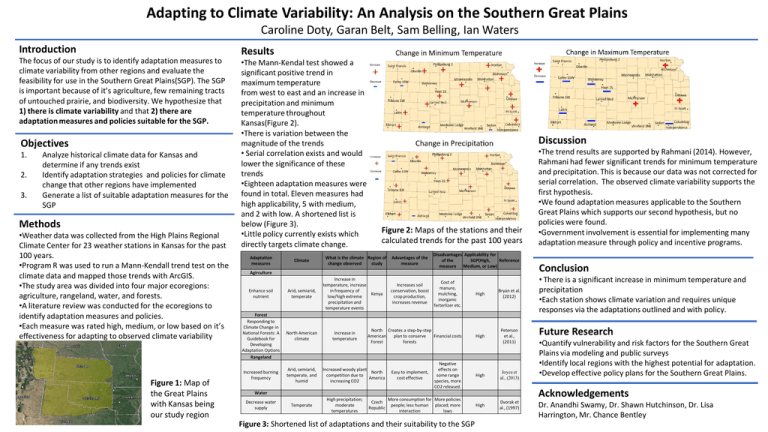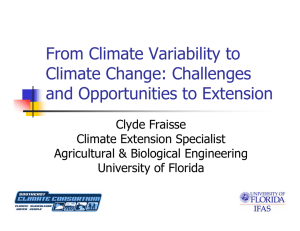Adapting to Climate Variability: An Analysis on the Southern Great... Caroline Doty, Garan Belt, Sam Belling, Ian Waters Introduction Results
advertisement

Adapting to Climate Variability: An Analysis on the Southern Great Plains Caroline Doty, Garan Belt, Sam Belling, Ian Waters Introduction The focus of our study is to identify adaptation measures to climate variability from other regions and evaluate the feasibility for use in the Southern Great Plains(SGP). The SGP is important because of it’s agriculture, few remaining tracts of untouched prairie, and biodiversity. We hypothesize that 1) there is climate variability and that 2) there are adaptation measures and policies suitable for the SGP. Objectives 1. 2. 3. Analyze historical climate data for Kansas and determine if any trends exist Identify adaptation strategies and policies for climate change that other regions have implemented Generate a list of suitable adaptation measures for the SGP Methods •Weather data was collected from the High Plains Regional Climate Center for 23 weather stations in Kansas for the past 100 years. •Program R was used to run a Mann-Kendall trend test on the climate data and mapped those trends with ArcGIS. •The study area was divided into four major ecoregions: agriculture, rangeland, water, and forests. •A literature review was conducted for the ecoregions to identify adaptation measures and policies. •Each measure was rated high, medium, or low based on it’s effectiveness for adapting to observed climate variability Figure 1: Map of the Great Plains with Kansas being our study region Results •The Mann-Kendal test showed a significant positive trend in maximum temperature from west to east and an increase in precipitation and minimum temperature throughout Kansas(Figure 2). •There is variation between the magnitude of the trends • Serial correlation exists and would lower the significance of these trends •Eighteen adaptation measures were found in total. Eleven measures had high applicability, 5 with medium, and 2 with low. A shortened list is below (Figure 3). •Little policy currently exists which directly targets climate change. Adaptation measures Climate Discussion Figure 2: Maps of the stations and their calculated trends for the past 100 years Advantages of the measure Disadvantages Applicability for of the SGP(High, Reference measure Medium, or Low) Increases soil conservation, boost crop production, increases revenue Cost of manure, mulching, inorganic ferterlizer etc. High Bryan et al. (2012) North Creates a step-by-step American plan to conserve Financial costs Forest forests High Peterson et al., (2011) Negative effects on some range species, more CO2 released. High Joyce et al., (2013) More consumption for More policies people; less human placed; more interaction laws High Dvorak et al., (1997) What is the climate Region of change observed study Agirculture Enhance soil nutrient Arid, semiarid, temperate Forest Responding to Climate Change in National Forests: A Guidebook for Developing Adaptation Options Rangeland North American climate Increased burning frequency Arid, semiarid, temperate, and humid Increase in temperature, increase in frequency of Kenya low/high extreme precipitation and temperature events Increase in temperature Increased woody plant North competition due to America increasing CO2 Easy to implement, cost effective Temperate High precipitation; moderate temperatures Czech Republic Figure 3: Shortened list of adaptations and their suitability to the SGP Conclusion • There is a significant increase in minimum temperature and precipitation •Each station shows climate variation and requires unique responses via the adaptations outlined and with policy. Future Research •Quantify vulnerability and risk factors for the Southern Great Plains via modeling and public surveys •Identify local regions with the highest potential for adaptation. •Develop effective policy plans for the Southern Great Plains. Acknowledgements Water Decrease water supply •The trend results are supported by Rahmani (2014). However, Rahmani had fewer significant trends for minimum temperature and precipitation. This is because our data was not corrected for serial correlation. The observed climate variability supports the first hypothesis. •We found adaptation measures applicable to the Southern Great Plains which supports our second hypothesis, but no policies were found. •Government involvement is essential for implementing many adaptation measure through policy and incentive programs. Dr. Anandhi Swamy, Dr. Shawn Hutchinson, Dr. Lisa Harrington, Mr. Chance Bentley



